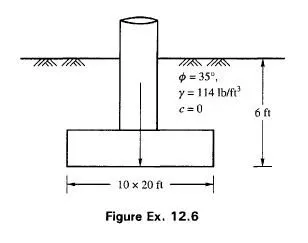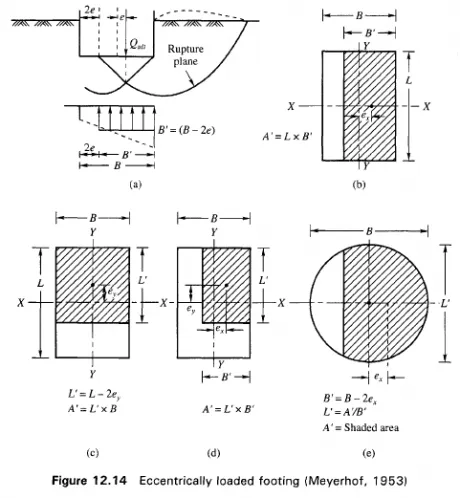One of the best known foundation failures occurred in October 1913 at North Transcona, Manitoba, Canada. It was ascertained later on that the failure occurred when the foundation pressure at the base was about equal to the calculated ultimate bearing capacity of an underlaying layer of plastic clay (Peck and Byrant,1953), and was essentially a shearing failure.
The construction of the silo started in 1911 and was completed in the autumn of 1913. The silo is 77 ft by 195 ft in plan and has a capacity of 1,000,000 bushels. It comprises 65 circular bins and 48 inter-bins. The foundation was a reinforced concrete raft 2 ft thick and founded at a depth of 12 ft below the ground surface. The weight of the silo was 20,000 tons, which was 42.5 percent of the total weight, when it was filled. Filling the silo with grain started in September 1913, and in October when the silo contained 875,000 bushels, and the pressure on the ground was 94 percent of the design pressure, a vertical settlement of 1 ft was noticed. The structure began to tilt to the west and within twenty four hours was at an angle of 26.9° from the vertical, the west side being 24 ft below and the east side 5 ft above the original level (Szechy, 1961).
The structure tilted as a monolith and there was no damage to the structure except for a few superficial cracks. Figure 12.22 shows a view of the tilted structure. The excellent quality of the reinforced concrete structure is shown by the fact that later it was underpinned and jacked up on new piers founded on rock. The level of the new foundation is 34 ft below the ground surface. Figure 12.23 shows the view of the silo after it was straightened in 1916. During the period when the silo was designed and constructed, soil mechanics as a science had hardly begun. The behavior of the foundation under imposed loads was not clearly understood. It was only during the year 1952 that soil investigation was carried out close to the silo and the soil properties were analyzed (Peck and Byrant, 1953). Figure 12.24 gives the soil classification and unconfmed compressive strength of the soil with respect to depth. From the examination of undisturbed samples of the clay, it was determined that the average water content of successive layers of varved clay increased with their depth from 40 percent to about 60 percent. The average unconfmed compressive strength of the upper stratum beneath the foundation was 1.13 tsf, that of the lower stratum was 0.65 tsf, and the weighted average was 0.93 tsf. The average liquid limit was found to be 105 percent; therefore the plasticity index was 70 percent, which indicates that the clay was highly colloidal and plastic. The average unit weight of the soil was 120 lb/ft3. The contact pressure due to the load from the silo at the time of failure was estimated as equal to 3.06 tsf. The theoretical values of the ultimate bearing capacity by various methods are as follows.





